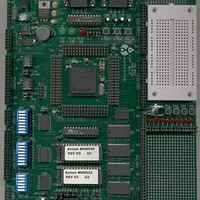MPC555CME Freescale Semiconductor, MPC555CME Datasheet - Page 520

MPC555CME
Manufacturer Part Number
MPC555CME
Description
KIT EVALUATION FOR MPC555
Manufacturer
Freescale Semiconductor
Type
Microcontrollerr
Datasheet
1.MPC555CME.pdf
(966 pages)
Specifications of MPC555CME
Contents
Module Board, Installation Guide, Power Supply, Cable, Software and more
Processor To Be Evaluated
MPC555
Data Bus Width
32 bit
Interface Type
RS-232
For Use With/related Products
MPC555
Lead Free Status / RoHS Status
Contains lead / RoHS non-compliant
- Current page: 520 of 966
- Download datasheet (13Mb)
14.8.7.9 Receiver Wake-Up
14.8.7.10 Internal Loop Mode
14.9 SCI Queue Operation
14.9.1 Queue Operation of SCI1 for Transmit and Receive
MPC555
USER’S MANUAL
The receiver wake-up function allows a transmitting device to direct a transmission to
a single receiver or to a group of receivers by sending an address frame at the start of
a message. Hardware activates each receiver in a system under certain conditions.
Resident software must process address information and enable or disable receiver
operation.
A receiver is placed in wake-up mode by setting the RWU bit in SCCxR1. While RWU
is set, receiver status flags and interrupts are disabled. Although the software can
clear RWU, it is normally cleared by hardware during wake-up.
The WAKE bit in SCCxR1 determines which type of wake-up is used. When WAKE =
0, idle-line wake-up is selected. When WAKE = 1, address-mark wake-up is selected.
Both types require a software-based device addressing and recognition scheme.
Idle-line wake-up allows a receiver to sleep until an idle line is detected. When an idle
line is detected, the receiver clears RWU and wakes up. The receiver waits for the first
frame of the next transmission. The data frame is received normally, transferred to the
RDRx, and the RDRF flag is set. If software does not recognize the address, it can set
RWU and put the receiver back to sleep. For idle-line wake-up to work, there must be
a minimum of one frame of idle line between transmissions. There must be no idle time
between frames within a transmission.
Address mark wake-up uses a special frame format to wake up the receiver. When the
MSB of an address-mark frame is set, that frame contains address information. The
first frame of each transmission must be an address frame. When the MSB of a frame
is set, the receiver clears RWU and wakes up. The data frame is received normally,
transferred to the RDRx, and the RDRF flag is set. If software does not recognize the
address, it can set RWU and put the receiver back to sleep. Address mark wake-up
allows idle time between frames and eliminates idle time between transmissions. How-
ever, there is a loss of efficiency because of an additional bit-time per frame.
The LOOPS bit in SCCxR1 controls a feedback path in the data serial shifter. When
LOOPS is set, the SCI transmitter output is fed back into the receive serial shifter. TXD
is asserted (idle line). Both transmitter and receiver must be enabled before entering
loop mode.
The SCI1 serial module allows for queueing on transmit and receive data frames. In
the standard mode, in which the queue is disabled, the SCI1 operates as previously
defined (i.e. transmit and receive operations done via SC1DR). However, if the SCI1
queue feature is enabled (by setting the QTE and/or QRE bits within QSCI1CR) a set
of 16 entry queues is allocated for the receive and/or transmit operation. Through soft-
/
MPC556
QUEUED SERIAL MULTI-CHANNEL MODULE
Rev. 15 October 2000
MOTOROLA
14-58
Related parts for MPC555CME
Image
Part Number
Description
Manufacturer
Datasheet
Request
R

Part Number:
Description:
MPC555 Interrupts
Manufacturer:
Freescale Semiconductor / Motorola
Datasheet:
Part Number:
Description:
Manufacturer:
Freescale Semiconductor, Inc
Datasheet:
Part Number:
Description:
Manufacturer:
Freescale Semiconductor, Inc
Datasheet:
Part Number:
Description:
Manufacturer:
Freescale Semiconductor, Inc
Datasheet:
Part Number:
Description:
Manufacturer:
Freescale Semiconductor, Inc
Datasheet:
Part Number:
Description:
Manufacturer:
Freescale Semiconductor, Inc
Datasheet:
Part Number:
Description:
Manufacturer:
Freescale Semiconductor, Inc
Datasheet:
Part Number:
Description:
Manufacturer:
Freescale Semiconductor, Inc
Datasheet:
Part Number:
Description:
Manufacturer:
Freescale Semiconductor, Inc
Datasheet:
Part Number:
Description:
Manufacturer:
Freescale Semiconductor, Inc
Datasheet:
Part Number:
Description:
Manufacturer:
Freescale Semiconductor, Inc
Datasheet:
Part Number:
Description:
Manufacturer:
Freescale Semiconductor, Inc
Datasheet:
Part Number:
Description:
Manufacturer:
Freescale Semiconductor, Inc
Datasheet:
Part Number:
Description:
Manufacturer:
Freescale Semiconductor, Inc
Datasheet:
Part Number:
Description:
Manufacturer:
Freescale Semiconductor, Inc
Datasheet:










